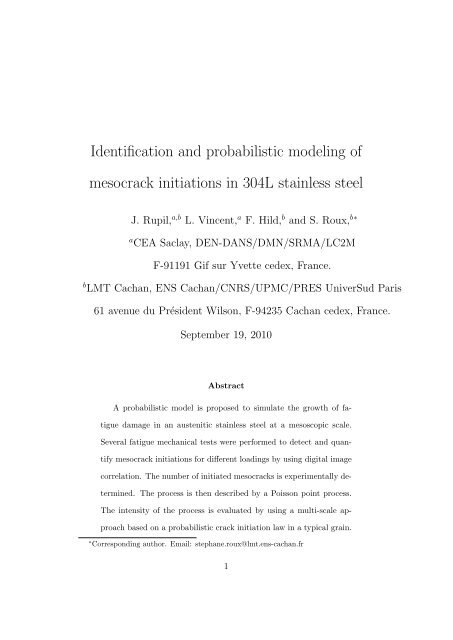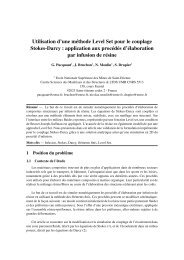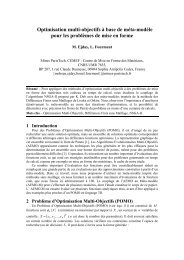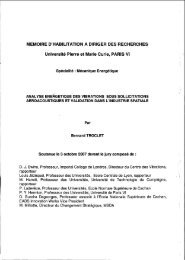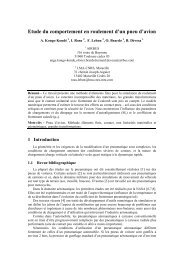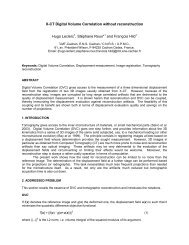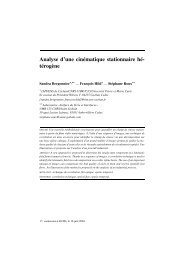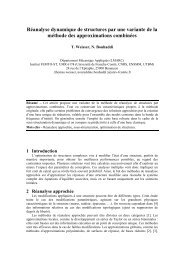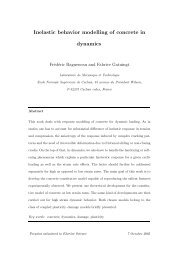Draft PDF - ENS Cachan
Draft PDF - ENS Cachan
Draft PDF - ENS Cachan
Create successful ePaper yourself
Turn your PDF publications into a flip-book with our unique Google optimized e-Paper software.
Identification and probabilistic modeling of<br />
mesocrack initiations in 304L stainless steel<br />
J. Rupil, a,b L. Vincent, a F. Hild, b and S. Roux, b∗<br />
a CEA Saclay, DEN-DANS/DMN/SRMA/LC2M<br />
F-91191 Gif sur Yvette cedex, France.<br />
b LMT <strong>Cachan</strong>, <strong>ENS</strong> <strong>Cachan</strong>/CNRS/UPMC/PRES UniverSud Paris<br />
61 avenue du Président Wilson, F-94235 <strong>Cachan</strong> cedex, France.<br />
September 19, 2010<br />
Abstract<br />
A probabilistic model is proposed to simulate the growth of fatigue<br />
damage in an austenitic stainless steel at a mesoscopic scale.<br />
Several fatigue mechanical tests were performed to detect and quantify<br />
mesocrack initiations for different loadings by using digital image<br />
correlation. The number of initiated mesocracks is experimentally determined.<br />
The process is then described by a Poisson point process.<br />
The intensity of the process is evaluated by using a multi-scale approach<br />
based on a probabilistic crack initiation law in a typical grain.<br />
∗ Corresponding author. Email: stephane.roux@lmt.ens-cachan.fr<br />
1
Keywords: Crack initiation; Digital image correlation; Identification;<br />
Mechanical fatigue; Poisson point process.<br />
1 Introduction<br />
Many industrial structures are submitted to mechanical or thermal fatigue<br />
loadings.<br />
If the material has no initial bulk or surface defects, a fatigue<br />
loading level greater than the fatigue limit initiates a critical damage (Ewing<br />
and Humfrey, 1903). For the two types of loading, namely mechanical or<br />
thermal, the major part of damage growth before fracture consists of random<br />
multi-initiations of short cracks on the surface.<br />
This phenomenon finally<br />
leads to the growth of either a main macrocrack in mechanical fatigue, or a<br />
crack network in thermal fatigue. In this paper we focus on the quantification<br />
of the multi-initiation stage of short cracks, which is a common feature of<br />
thermal and mechanical fatigue (Maillot, 2003).<br />
It has been established in monocrystalline materials (Mughrabi et al.,<br />
1979) that microcrack initiation is based on dislocation pile up in Persistant<br />
Slip Bands (PSB) on the surface grains. These PSBs induce a surface topography,<br />
which is experimentally observed and quantified (Mughrabi et al.,<br />
1983; Ma and Laird, 1989; Man et al., 2002), called extrusions and localized<br />
in bands. The induced local stress concentrations on these bands may<br />
eventually induce the nucleation of a transgranular microcrack. The physical<br />
mechanism of crack initiation is now well described in the literature for<br />
monocrystalline material and will not be discussed herein.<br />
Moreover, the<br />
phenomenon of local initiation in one grain has already been modeled the-<br />
2
oretically (Mura, 1994), and numerically by discrete dislocations dynamics<br />
simulations (Déprés et al., 2006).<br />
After nucleation, the microcrack mainly follows a shear stress propagation<br />
mode along PSBs. This phase corresponds to stage I of fatigue crack<br />
growth (Forsyth, 1961). The study presented herein focuses on the next stage<br />
corresponding to the transition from the shear stress propagation mode in<br />
one grain to the normal stress propagation mode across several grains. In this<br />
phase, the propagation is microstructure-dependent. The crack may often be<br />
pinned at grain or twin boundaries. The latters represent barriers for classical<br />
propagation modes based on Stress Intensity Factors (SIF) computations.<br />
In that case and when the initiated microcrack density is large enough, crack<br />
growth by coalescence of neighboring microcracks is effective (Magnin et al.,<br />
1985).<br />
Some authors (Lindborg, 1969; Fedelich, 1998; Zhai et al., 2000) then<br />
proposed different solutions to model the coalescence of microcracks. Another<br />
numerical study (Hoshide and Socie, 1988) simulated the competition<br />
between the two types of propagation modes. When the crack becomes large<br />
enough, the propagation can only be described by a self-propagation mode<br />
based on SIFs. The assumption is made that if the short crack is long enough<br />
(compared with the characteristic size of the microstructure) to have a growth<br />
well described by a deterministic propagation law then it is called mesocrack.<br />
At this stage, the mesocrack is still not in Paris’ (Paris and Erdogan, 1963)<br />
propagation regime but is no more microstructure-dependent (i.e., it is physically<br />
short but microstructurally long (Miller, 1997)).<br />
The behavior of a unique mesocrack from its microstructural size to a<br />
3
(potentially fatal) macrocrack is modeled with the use of a propagation law<br />
representative of short cracks. A recent probabilistic model (Malésys et al.,<br />
2009) proposes to simulate the behavior of multiple mesocracks in an interacting<br />
network. This model needs data on mesocrack initiation. Hence, the<br />
main objective of this paper is to propose a probabilistic law for the change<br />
of the mesocrack density in uniaxial mechanical fatigue. This law describes<br />
the local (random) conditions for microcrack initiations as discussed before.<br />
Several stochastic models have been proposed to simulate mesocrack densities.<br />
They are often based on Monte-Carlo simulations (Suh et al., 1992;<br />
Bataille and Magnin, 1994; Argence, 1996; Osterstock et al., 2007) and identified<br />
by using few experimental data. Since the initiation phenomenon in<br />
fatigue occurs generally on the surface and at a very small scale, classical<br />
macroscopic measurements do not allow the experimentalist to get quantitative<br />
data of this process. For example, damage quantification based on<br />
Young’s modulus variations (Desmorat et al., 2007) can only describe the<br />
initiation of a macrocrack (corresponding to 90 % of fatigue lifetime). The<br />
process modeled herein starts from 10 % of fatigue lifetime and mesocrack<br />
initiation occurs around 60 % of fatigue lifetime (Magnin et al., 1985).<br />
The only way to identify a model is therefore to perform fatigue mechanical<br />
tests with microcrack detection methods.<br />
Several techniques are<br />
currently used, namely, replica (Chauvot and Sester, 2000), in situ optical<br />
(Malésys, 2007; El Bartali et al., 2008) or SEM (Vasek and Polak, 1991)<br />
observations. Application of such techniques is most of the time long and<br />
difficult. However, multi-initiations of short cracks at the mesoscopic scale<br />
have been observed for uniaxial (Hua and Socie, 1984; Magnin et al., 1985)<br />
4
and more complex loadings (Weiss and Pineau, 1993). As existing experimental<br />
data are scarce, new tests were performed for the studied material.<br />
The experimental quantification of the phenomenon is difficult because of<br />
the size of the cracks compared with that of the gauge surface. Moreover<br />
neither the location nor the number of cycles to initiation are well known.<br />
Therefore, in many studies the surface of crack detection is very small to<br />
locate more easily the cracks. However, it is more difficult to have a statistically<br />
representative surface. Several tests were performed with the use of<br />
a Digital Image Correlation (DIC) technique at the mesoscopic scale using a<br />
digital camera. This approach is not as accurate as the techniques alluded to<br />
before, but it allows us to couple two experimental constrains, namely, fine<br />
local heterogeneity quantifications and fast visualization of damage growth.<br />
The paper is divided into three parts. In the first one, the experimental<br />
procedure and the results are presented.<br />
The modeling strategy used to<br />
derive the mesocrack initiation density is discussed in the second part. Last,<br />
the experimental results are compared with the predictions given by the<br />
probabilistic model.<br />
2 Experimental procedure<br />
2.1 Experimental setup<br />
The studied material is an AISI 304L stainless steel. It is one of the main<br />
materials used to make pipes in nuclear power plants.<br />
It is a polycrystalline<br />
austenitic steel (Figure 1) containing residual ferrite (approximatively<br />
5
4 wt%). The average grain size is equal to 40 µm.<br />
Figure 1: 304L microstructure made of austenitic grains (gray) with ferritic<br />
residual grains (black).<br />
The global geometry of the specimen (Figure 2) is similar to classical<br />
fatigue samples. To monitor the damage stage with DIC, a gauge surface is<br />
obtained by machining a planar zone (Figure 2). This type of notched geometry<br />
has already been successfully used (Vasek and Polak, 1991; Malésys,<br />
2007) for observations of crack initiations. The geometry was slightly modified<br />
to obtain a larger surface of observation. The shallow notch creates a<br />
local stress heterogeneity on the surface in order to localize initiations. The<br />
notch area is mechanically polished. A final electropolishing is performed<br />
resulting in a good quality of the surface finish suitable for optical observations.<br />
Figure 1 shows a microscopic observation carried out after surface<br />
polish. The stress and strain concentrations due to the notch were estimated<br />
to be equal to 1.05 (Polak and Zezulka, 2005).<br />
6
Figure 2: Geometry of the specimen with a flat part (0.4 mm in depth) in<br />
the center of the gauge zone (Malésys, 2007)<br />
Specimens are cycled by sine-wave loading (5 Hz frequency) in a servohydraulic<br />
fatigue testing machine . Stress amplitude ∆σxx<br />
2<br />
is controlled for all<br />
the tested samples. The total strain is measured by an extensometer (gauge<br />
length: 10 mm). Periodically (the period depends on the test, namely, around<br />
10% of the fatigue life), the maximum load is maintained during 0.2s and<br />
a picture acquisition is automatically triggered. The images are captured<br />
with a digital single lens reflex camera (CANON EOS 5D) and a macro lens<br />
(CANON MPE65) with a magnification of × 5. The data are gray level raw<br />
images with a resolution of 3 Mpixels for a notch surface of 3 × 5 mm 2 . The<br />
final pixel size on the raw pictures is 3.2 µm. Contrary to other methods used<br />
for visual crack detection (e.g., based on SEM or optical microscope observations),<br />
the raw pictures (Figure 3a) cannot be used because the pixel size<br />
prevents any observation of small cracks with an opening less than 3.2 µm.<br />
The cracks are detected on the raw images only when their sizes reach half<br />
7
the width of the notch. Therefore, the quantification of mesocrack densities<br />
is only possible with the use of a post-processing technique.<br />
2.2 Full field measurement technique<br />
In the present case DIC is used to detect and quantify mesocrack initiations.<br />
DIC is based on the minimization of the correlation residuals between the<br />
two considered images. Let f denote the reference picture, g that of a later<br />
state of the observed surface, and u(x) the unknown in-plane displacement<br />
at the (pixel) location x. The local correlation residual<br />
ϕ(x) = |f(x) − g(x + u(x))| (1)<br />
consists in computing the gap to brightness conservation. Its dimensionless<br />
counter-part ˜ϕ is obtained by dividing ϕ by the dynamic range of the reference<br />
picture (i.e., max(f) − min(f)). In the present case a global approach<br />
to DIC is chosen. Consequently, the global residual defined over the region<br />
of interest (ROI)<br />
∫<br />
Φ 2 = ϕ 2 (x)dx (2)<br />
ROI<br />
is minimized with respect to the kinematic unknowns. The latters are the<br />
degrees of freedom associated with a Q4 finite element discretization based<br />
on 4-noded elements (with bilinear interpolations). It is therefore referred<br />
to as Q4-DIC (Besnard et al., 2006). One classical way of obtaining a good<br />
texture is to spray paint to get a random pattern. However, the paint may<br />
hide microcrack initiations. As in other experimental studies (Malésys, 2007;<br />
El Bartali et al., 2008), the texture is the natural contrast of the revealed<br />
microstructure.<br />
8
As in finite element computations, the ROI is uniformly meshed with Q4<br />
elements each made of a square of l × l pixels, so that l defines the element<br />
size. The technique gives access to the displacement field in each pixel of<br />
any element of the ROI. At the beginning of the test, there is no crack on<br />
the surface. The images are taken for the same load level. Consequently,<br />
the displacement field only corresponds to the residual strains due to cyclic<br />
hardening or softening (and a possible rigid body motion). A typical result<br />
is shown in Figure 3 for a test with ∆σxx<br />
2<br />
= 200MPa. The reference picture is<br />
shot at the maximum level of the first cycle. The second picture is then shot<br />
after 30,000 cycles. The measured displacement field in the loading direction<br />
(a)<br />
(b)<br />
Figure 3: (a) Raw picture and region of interest (dashed box). (b) Longitudinal<br />
displacement field (in pixels) after 30,000 cycles (1 pixel ↔ 3.2 µm)<br />
is shown in Figure 3b.<br />
This map shows a displacement gradient related<br />
9
to cyclic softening of the material.<br />
For this material (304L) and for the<br />
studied domain of fatigue lifetime (i.e., > 10,000 cycles), the cyclic behavior<br />
is composed of three phases, namely, primary hardening, cyclic softening<br />
and finally secondary hardening (Poncelet et al., 2010; Colin et al., 2010).<br />
Since the behavior is not stabilized in the presented test, the reference image<br />
is from now on chosen to be the first one just after cyclic softening. As a<br />
consequence, the mean strain between the two images used for correlation is<br />
minimized.<br />
To assess the quality of the texture, the measurement uncertainty is evaluated<br />
a priori on the considered reference picture (Besnard et al., 2006). It<br />
is obtained by prescribing a known displacement (here 0.5 pixel, which is<br />
known to be the worst case because of gray level interpolation bias). The<br />
comparison between the measured displacement and the prescribed one gives<br />
the bias (which is negligible) and the standard deviation, providing an evaluation<br />
of the displacement uncertainty. The relationship between the standard<br />
uncertainty and the element size follows a power law<br />
σ u = Aα+1<br />
l α (3)<br />
where σ u is the standard displacement uncertainty, and A, α are two constants.<br />
The identified values are A = 1.15 pixel, and α = 1.7.<br />
This first analysis only evaluates the intrinsic performance of the correlation<br />
code with the texture at hand (labeled “computational uncertainty”<br />
in Figure 4). However, it does not take in account the uncertainty resulting<br />
from experimental conditions. Therefore, the resolution has also been quantified.<br />
Just before the starting the test, 10 images are shot for a fixed load<br />
10
Figure 4: Uncertainty and resolution analyses. Standard displacement uncertainty<br />
as a function of the element size l.<br />
level close to zero. For each picture a displacement measurement is performed<br />
for different element sizes. For each couple of images and element size, the<br />
displacement field corresponds to a distribution of local displacements. From<br />
these distributions, the mean value and the standard deviation are computed.<br />
The latter is compared with the value observed in the uncertainty analysis.<br />
This (experimental) approach takes all the sources of uncertainty (labeled<br />
“global uncertainty” in Figure 4) into account such as testing machine vibrations,<br />
acquisition noise, lighting conditions.<br />
The graph shows that for<br />
small element sizes most of the uncertainty comes from the correlation code<br />
whereas for large elements, the correlation uncertainty is very low compared<br />
to that caused by the experimental conditions.<br />
Let us now assume that a crack has appeared on the surface.<br />
In the<br />
11
literature, DIC has already been used to detect crack propagation (Sutton<br />
et al., 2001; Hamam et al., 2007). In most cases large cracks are studied,<br />
with various opening levels.<br />
In the present case the displacement field is<br />
analyzed. In particular, in the vicinity of small cracks, the displacements become<br />
discontinuous. As a consequence, local displacements around the crack<br />
are slightly altered. Figure 5a shows the same type of result as Figure 3b but<br />
after 80,000 cycles of loading. This stage corresponds to the first detection<br />
of mesocrack initiation.<br />
(a)<br />
(b)<br />
Figure 5: (a) Longitudinal displacement field in pixel (1 pixel ↔ 3.2 µm).<br />
(b) Normalized correlation residual field ˜ϕ.<br />
The use of 4-pixel elements gives the best (i.e., lowest) spatial resolution<br />
in terms of crack detection.<br />
Let us emphasize that this low value is<br />
remarkable in view of the texture at hand. Such low sizes are accessible only<br />
thanks to the global approach to DIC used herein.<br />
The quantification of<br />
the uncertainty shows that for the smallest elements used (i.e., l = 4 pix-<br />
12
els) the standard displacement uncertainty is about 0.2 pixel (or 0.6 µm).<br />
The measured level of crack opening is at most of the order of 0.4 pixel (or<br />
1.3 µm). The total range of the displacements shown in Figure 5a is equal to<br />
1 pixel. All the displacements are less than 1 pixel (or 3.2 µm). This result<br />
leads to several conclusions. First, for crack openings less than the pixel size,<br />
the crack is not detectable on the residual map (Figure 5b). Second, the<br />
uncertainty evaluation gives also a good estimate of the threshold for crack<br />
detection using a DIC technique. Experimentally a crack is detectable when<br />
its opening is greater than 0.4 pixel, which is twice the standard displacement<br />
uncertainty. This type of crack has a length of about 150 µm (or 4 grains).<br />
2.3 Experimental results<br />
The DIC technique is performed for all the recorded pictures and multiinitiation<br />
is noted on the next displacement field maps. Figure 6a illustrates<br />
this result and corresponds to the displacement field after 120,000 cycles of<br />
loading. The test is interrupted when the macrocrack traverses the whole flat<br />
part (for the case presented, it corresponds to 132,000 cycles). At this stage<br />
the specimen is not broken yet and a change of macroscopic data (i.e., strain<br />
given by the extensometer) only begins to be observed. Quantitatively, the<br />
two biggest mesocracks have an opening greater than the pixel size and they<br />
are now appearing on the correlation residual map (Figure 6b).<br />
In the following, the main results concerning crack density changes are<br />
presented.<br />
The density is computed as the number of cracks “manually”<br />
counted on the pictures (as in Figure 6a) and divided by the area of the<br />
13
(a)<br />
(b)<br />
Figure 6: (a) Longitudinal displacement field in pixel (1 pixel ↔ 3.2 µm).<br />
(b) Normalized correlation residual field ˜ϕ.<br />
ROI. This choice is made even though the notch induces a (small) local stress<br />
heterogeneity. This hypothesis is experimentally confirmed since at the end<br />
of the test the major part of the notch is covered with cracks (Figure 6a).<br />
For a particular load level (i.e., 210 MPa), several results are collected. The<br />
mesocrack density change is shown in Figure 7. The points represent the<br />
mesocrack density change for 5 specimens labeled A26-xxx. The number of<br />
cycles to fracture lies between 50,000 and 75,000 cycles. All the densities are<br />
given for a number of cycles (N) divided by the number of cycle when the<br />
test was interrupted (NR).<br />
Figure 7 illustrates the uncertainty related to the density change with the<br />
‘same’ material (taken from the same raw bar) and at the same loading level.<br />
The beginning of initiation is always around 60 and 70 % of lifetime but the<br />
final density varies between 1 and 3 cracks / mm 2 . It confirms the randomness<br />
of the crack initiation process but shows also the same effect in terms of<br />
14
mesocrack densities. It also proves the need for performing several tests for<br />
each load level to have a good estimate of the probabilistic parameters (e.g.,<br />
mean and standard deviation) associated with the initiation process.<br />
Figure 7: Density changes with the normalized number of cycles for 5 specimens<br />
with the same load level.<br />
Figure 8 shows the comparison of 4 tests at different load levels ranging<br />
from 190 to 220 MPa. In the 220 MPa loading level case, the density at<br />
the end of the test is less than that obtained for lower loading levels such<br />
as 210 or 200 MPa. Post-mortem observations using optical microscopy for<br />
each test revealed that the 220 MPa test presents a larger density of small<br />
cracks (length less than 150µm) than the other tests (with a lower loading<br />
level).<br />
This result confirms that for high stress levels, most of the short<br />
cracks are pinned on grain or twin boundaries, and do not find the right<br />
conditions in the neighboring grain to become long enough to be detected<br />
by the DIC technique.<br />
It also reveals the competition between multiple<br />
15
mesocrack initiations and propagation of the first initiated mesocrack leading<br />
to failure. In the 220 MPa case, the first mesocrack propagation is too fast<br />
to let numerous other mesocracks initiate on the surface.<br />
Figure 8: Density changes for 4 specimens with different stress levels.<br />
3 Probabilistic modeling<br />
The initiation of microcracks is modeled by a Poisson Point Process<br />
(PPP) (Denoual et al., 1997; Doudard et al., 2005; Malésys et al., 2009)<br />
P (N µ = ν, Ω) = (λZ)ν<br />
ν!<br />
exp(−λZ) (4)<br />
where P (N µ = ν, Ω) denotes the probability of finding ν cracks in domain<br />
Ω, Z the surface of Ω where initiation takes place, and λ the intensity of<br />
the PPP (i.e., the mean mesocrack density).<br />
This type of law has been<br />
experimentally confirmed for crack initiations (Weiss, 1992).<br />
16
The intensity λ of the PPP has to be identified. Moreover, this variable<br />
depends mostly on the loading and the number of cycles N.<br />
Malésys et<br />
al. (2009) proposed an approach based on Weibull’s theory (i.e., λ is given<br />
by a power function of the stress amplitude).<br />
This theory only uses the<br />
endurance stress and the standard deviation to identify the parameters of<br />
that function.<br />
However, the extension of the theory to higher load levels<br />
turned out to be quite far from experimental results. The objective is to<br />
propose a new law for λ in the high and intermediate levels of loading. The<br />
intensity is modeled by a function Ψ to be determined<br />
λ = Ψ(∆σ, N, ...) (5)<br />
where Ψ may depend on a macroscopic loading variable such as the stress<br />
amplitude ∆σ, on the number of cycles N, and possibly on other parameters<br />
to be determined.<br />
The starting point of the model developed herein is to quantify the probability<br />
of initiating a microcrack in a single grain. The main condition for<br />
microcrack initiation is given by the height of extrusion/intrusion profiles<br />
which is related to the level of local plastic strain amplitudes in the grain as<br />
a first approximation. At the scale of the aggregate, the mechanical fields are<br />
necessarily heterogeneous due to the complex interactions between grains of<br />
different shapes and crystallographic orientations. If this aggregate is loaded<br />
in fatigue with a macroscopic stress inducing a macroscopic plastic strain,<br />
each grain of the aggregate is going to experience a different local plastic<br />
strain level, and thus a different probability of initiating a microcrack after<br />
N cycles.<br />
To relate the plastic strain and the number of cycles to crack<br />
17
initiation, Mura (1994) proposed a theoretical model for uniaxial loadings.<br />
Déprés (2004) also proposed an initiation law for uniaxial and biaxial loadings<br />
as well. These two types of model lead to the same conclusion concerning the<br />
uniaxial case without mean stress effects. The number of cycles to initiation<br />
N i is written as<br />
N i = F (D g, γ, K)<br />
∆ɛ p<br />
2<br />
(6)<br />
where F is a function depending on several parameters such as the characteristic<br />
grain size D g , the criterion for surface creation γ and a constant<br />
K.<br />
For each grain several parameters in this law are different, mainly the<br />
geometry and the mean plastic activity. Déprés’ law (2004) is used and two<br />
variables become probabilistic, namely, the depth of the grain (h g , representing<br />
the geometric randomness) and the local plastic strain (∆ɛ p , representing<br />
the local loading variations)<br />
√<br />
Ni =<br />
D gγ<br />
kh g ∆ɛ p<br />
(7)<br />
where D g is equal to 40 µm, and γ is equal to 0.75 (Osterstock, 2008). The<br />
last parameter k will be identified using the above presented experimental<br />
results. Maillot (Maillot, 2003) shows that the grain size distribution for this<br />
material is log-normal<br />
p(h g ) =<br />
[<br />
1<br />
√ exp − 1 ( ) ] 2 ln(hg ) − µ h<br />
h g σ h 2π 2 σ h<br />
(8)<br />
with<br />
(<br />
)<br />
E(h g ) 2<br />
µ h = ln √<br />
E(hg ) 2 + V ar(h g )<br />
(9)<br />
18
and<br />
( )<br />
V<br />
σh 2 ar(hg )<br />
= ln<br />
E(h g ) + 1 2<br />
(10)<br />
The parameters E(h g ) and V ar(h g ) denote respectively the expectation and<br />
variance of the distribution. The following values are chosen: E(h g ) = D g /2<br />
and V ar(h g ) = E(h g ) 2 /16. p(h g ) is the probability density function (pdf) of<br />
the log-normal distribution. The plastic strain distribution is also assumed<br />
to be log-normal. The first comparisons with polycrystalline computations<br />
show that this hypothesis is reasonable (Le Pecheur, 2008; Sauzay et al., 2010;<br />
Li, 2011). The pdf is the same as in Equation (8). The polycrystalline computations<br />
cited before also motivate the choice of the mean and variance such<br />
that E(∆ɛ p ) = ∆E p and V ar(∆ɛ p ) = ∆E 2 p/9, ∆E p being the macroscopic<br />
plastic strain. One additional hypothesis is the statistical independence of<br />
the two variables. Equation (7) is also written as<br />
with<br />
ln(∆ɛ p ) + ln(h g ) = ln(K) − ln(N i)<br />
2<br />
K = D gγ<br />
k<br />
= ∆ (11)<br />
(12)<br />
The variable ∆ (as the sum of two Gaussian independent random variables,<br />
ln(∆ɛ p ) and ln(h g )) also follows a normal distribution. The probability<br />
of initiating a crack before a given number of cycles N is equal to the cumulative<br />
probability of the normal distribution ∆<br />
P (N i < N) = 1 [ ( )]<br />
ln(K) − (1/2) ln(Ni ) − µ ∆<br />
1 − erf<br />
2<br />
2 √ 2σ ∆<br />
(13)<br />
with<br />
µ ∆ = µ h + µ ∆ɛp (14)<br />
19
and<br />
σ ∆ =<br />
√<br />
σ 2 ∆ + σ2 ∆ɛ p<br />
(15)<br />
It is possible to obtain (see Equation (13)) and compute the probability<br />
of having one microcrack in one grain of the aggregate for different applied<br />
loadings (Figure 9).<br />
Figure 9: Probability of initiating a microcrack for different macroscopic<br />
plastic strain variations.<br />
Let us now focus on the calculation of the mesocrack density. An aggregate<br />
made of n grains aligned along one direction (1D problem), and<br />
subjected to a uniaxial loading (perpendicular to the direction of the grain<br />
alignment). For each number of cycles, the probability of crack initiation is<br />
the same for all the grains and corresponds to P (N i < N) = P . The microscopic<br />
growth of cracks is assumed to be described by coalescence (Lindborg,<br />
1969). This assumption induces the coalescence of 2 neighboring microcracks<br />
20
forming a longer microcrack. The same process enables for the creation of<br />
cracks of length 3, 4, 5, etc. grains. The condition of having an amount of<br />
k cracks aligned among the n grains is that each amount of k grains should<br />
be surrounded by 2 grains that did not initiate a crack. Let P denote the<br />
probability of initiation and Q = 1−P the probability of non initiation. The<br />
number of amounts of k initiated grains A k reads<br />
A k = nQ 2 P k (16)<br />
The number of cracks we are interested in for comparison purposes with<br />
the experimental results is cracks of length equal to or greater than m grains.<br />
This number of cracks A >m is given by<br />
n∑<br />
A >m = nQ 2 P i = nQ 2 P m (1 + P + P 2 + ... + P n−m ) ≈ nQP m (17)<br />
i=m<br />
and the density is obtained by dividing the number of cracks by the considered<br />
surface S. For the sake of simplicity, a square shape is assumed for the<br />
aggregate so that S = nDg. 2 Moreover, in the 2D case, the microstructure is<br />
described by a regular array of square grains. The density of cracks whose<br />
length is larger than m grains becomes<br />
λ m = 1 D 2 g<br />
(1 − P (N i < N))P (N i < N) m (18)<br />
There is one remaining parameter to be identified, namely, the initiation<br />
coefficient k of Equation (7).<br />
The experimental results for the particular<br />
loading of 210MPa shown in Figure 7 are used to identify k = 1.75.<br />
21
4 Comparisons with experiments<br />
Two comparisons are carried out. The first one concerns the above presented<br />
experimental results, and others found in the literature (Bataille and Magnin,<br />
1994) in which the density change of smaller crack sizes were detected.<br />
4.1 Comparisons for the different load levels<br />
The density we are interested in for comparison purposes with the experimental<br />
results is for cracks whose length is greater than or equal to 4 grains (i.e.,<br />
the length that is detected with the correlation technique, see Section 2.2).<br />
The density is given by<br />
λ = 1 D 2 g<br />
(1 − P (N i < N))P (N i < N) 4 (19)<br />
The results for the mean density is compared with the experimental result<br />
of Figure 10. The model describes well the impact of plastic strain on the<br />
density change.<br />
When the load level becomes closer to the fatigue limit,<br />
the assumption of large microcrack densities becomes less valid. As a consequence,<br />
the model predicts a mesocrack density greater than the one recorded<br />
(see case 180 MPa in Figure 10). Hence, for low loading levels, a threshold on<br />
the plastic strain amplitude may be added in the initiation criterion. Such a<br />
modification in the model would delay the mesocrack initiations only for low<br />
loading amplitudes.<br />
22
Figure 10: comparison between experimental crack densities evolution and<br />
model prediction<br />
4.2 Comparison for different crack sizes<br />
Magnin et al. (1985) performed a uniaxial mechanical fatigue test with a<br />
high level of plastic strain on a 316L stainless steel and recorded the crack<br />
density changes using a replication technique. This technique is long to set<br />
up but allows them to detect one grain-long microcrack (called type I). The<br />
results are reported in Figure 11a. They also noted the mesocrack density<br />
changes for type II cracks (between 2 and 3 grain long) and type III cracks<br />
(sizes greater than or equal to 4 grains). Figure 11b shows the predictions<br />
of the model developed herein. The value of the k parameter is identical to<br />
that determined for 304L stainless steel. Without any modification of the<br />
model or parameters, a good agreement is observed. This result shows that<br />
the predictive capacity of the present model is good.<br />
23
(a)<br />
(b)<br />
Figure 11: (a) Experimental results for multiple initiation of microcracks<br />
(type I), short mesocracks (type II) and mesocracks (type III) after Bataille<br />
and Magnin (Bataille and Magnin, 1994). (b) Model predictions for the same<br />
type of crack density changes.<br />
5 Summary<br />
Several uniaxial fatigue mechanical tests in tension-compression have been<br />
performed on a 304L stainless steel.<br />
A flat part on the specimen gauge<br />
surface is monitored with a classical digital camera.<br />
The use of the raw<br />
pictures coupled with a global digital image correlation technique enables us<br />
to follow the crack density changes for mesocracks longer than 150µm.<br />
A probabilistic model for microcrack nucleation and coalescence is proposed<br />
and leads to a good agreement with the experimental results. While<br />
most of existing models are based on numerical Monte Carlo simulations,<br />
the model presented herein gives an analytical law only dependent on the<br />
microstructure size and the macroscopic plastic strain distributions.<br />
The<br />
particular case of low fatigue loading is not currently well simulated since no<br />
threshold parameter on the plastic strain is used.<br />
24
The approach developed herein can be improved by using numerical results<br />
of discrete dynamic dislocation or polycrystalline finite element simulations.<br />
The remaining hypothesis concerning local heterogeneity for the plastic<br />
strain and the independence between the microstructure and the plastic<br />
strain will be studied by performing polycrystalline finite element simulations<br />
on “real” aggregates of 304L stainless steel. Moreover, this study reveals the<br />
need for more experimental data at the smallest scales.<br />
In that way, improvement<br />
in DIC technique for microcrack detection could lead to a better<br />
understanding of the local phenomenon driving initiation and propagation of<br />
microcracks.<br />
References<br />
Argence, D. (1996). Endommagements couplés de fatigue et de fluage sous<br />
chargement multiaxial. PhD thesis, Ecole des Mines de Paris.<br />
Bataille, A. and Magnin, T. (1994). Surface damage accumulation in lowcycle<br />
fatigue - physical analysis and numerical modeling. Acta Metallurgica<br />
Et Materialia, 42:3817–3825.<br />
Besnard, G., Hild, F., and Roux, S. (2006). Finite element diplacement fields<br />
analysis from digital images: Application to portevin-le chatelier bands.<br />
Experimental Mechanics, 46:789–803.<br />
Chauvot, C. and Sester, M. (2000). Fatigue crack initiation and crystallographic<br />
crack growth in an austenitic stainless steel. Computational Materials<br />
Science, 19:87–96.<br />
25
Colin, J., Fatemi, A., and Taheri, S. (2010). Fatigue behavior of stainless<br />
steel 304l including strain hardening, prestraining, and mean stress effects.<br />
Journal of Engineering Materials and Technology, 132:021008,1–13.<br />
Denoual, C., Barbier, G., and Hild, F. (1997). A probabilistic approach for<br />
fragmentation of brittle materials under dynamic loading. Comptes Rendus<br />
De L’Academie Des Sciences Série Ii Fascicule B-Mécanique Physique<br />
Astronomie, 325:685–691.<br />
Déprés, C. (2004). Modélisation physique des stades précurseurs de<br />
l’endommagement en fatigue dans l’acier inoxydable austénitique 316L.<br />
PhD thesis, Institut national polytechnique de Grenoble.<br />
Déprés, C., Robertson, C., and Fivel, M. (2006). Low-strain fatigue in 316l<br />
steel surface grains: a three dimension discrete dislocation dynamics modelling<br />
of the early cycles. part 2: Persistent slip markings and micro-crack<br />
nucleation. Philosophical Magazine, 86:79–97.<br />
Desmorat, R., Kane, A., Seyedi, M., and Sermage, J. (2007).<br />
Two scale<br />
damage model and related numerical issues for thermo-mechanical high<br />
cycle fatigue. European Journal of Mechanics a-Solids, 26:909–935.<br />
Doudard, C., Calloch, S., Cugy, P., and Hild, F. (2005). A probabilistic twoscale<br />
model for high-cycle fatigue life predictions. Fatigue and Fracture of<br />
Engineering Materials and Structures, 28:279–288.<br />
El Bartali, A., Aubin, V., and Degallaix, S. (2008). Fatigue damage analysis<br />
in a duplex stainless steel. Fatigue and Fracture of Engineering Material<br />
and Structures, 31:137–151.<br />
26
Ewing, J. A. and Humfrey, J. C. (1903). The fracture of metals under repeated<br />
alternations of stress. Phil. Trans. Royal Society, CC:241–250.<br />
Fedelich, B. (1998). A stochastic theory for the problem of multiple surface<br />
crack coalescence. International Journal of Fracture, 91:2345.<br />
Forsyth, P. (1961). A two stage process of fatigue crack growth. Proc. Symp.<br />
Crack Propagation, pages 76–94.<br />
Hamam, R., Hild, F., and Roux, S. (2007). Stress intensity factor gauging by<br />
digital image correlation: Application in cyclic fatigue. Strain, 43:181–192.<br />
Hoshide, T. and Socie, D. (1988). Crack nucleation and growth modeling in<br />
biaxial fatigue. Engineering Fracture Mechanics, 29:287–.<br />
Hua, C. and Socie, D. (1984). fatigue damage in 1045 steel under constant<br />
amplitude biaxial loading. Fatigue Engng. Mater.Structure, 7:165–179.<br />
Le Pecheur, A. (2008).<br />
Compréhension des mécanismes et prévision de<br />
l’amorçage en fatigue thermique des aciers austénitiques, prenant en<br />
compte l’état de surface et le caractère multi-axial du chargement. PhD<br />
thesis, Ecole Centrale de Paris.<br />
Li, Y. (for 2011). Contribution à l’étude de l’endommagement par fatigue à<br />
l’aide d’un modèle polycristallin. PhD thesis, Ecole Centrale de Paris.<br />
Lindborg, U. (1969). A statistical model for the linking of microcracks. Acta<br />
Matalurgica, 17:521–526.<br />
Ma, B. and Laird, C. (1989). Overview of fatigue behavior in copper single<br />
crystals (parts 1 to 5). Acta Metallurgica, 37(2):325–379.<br />
27
Magnin, T., Coudreuse, L., and Lardon, J. (1985). A quantitative approach<br />
to fatigue damage evolution in fcc and bcc stainless-steels. Scripta Metallurgica,<br />
19:1487–1490.<br />
Maillot, V. (2003). amorçage et propagation de reseaux de fissures de fatigue<br />
thermique dans un acier inoxydable austénitique de type X2 CrNi 18-09<br />
(AISI 304L). PhD thesis, Ecole Centrale de Lille.<br />
Malésys, N. (2007). Modélisation probabiliste de la formation de réseaux de<br />
fissures en fatigue thermique.<br />
PhD thesis, Ecole Normale Suprieure de<br />
<strong>Cachan</strong>.<br />
Malésys, N., Vincent, L., and Hild, F. (2009).<br />
A probabilistic model to<br />
predict the formation and propagation of crack networks in thermal fatigue.<br />
International Journal of Fatigue, 31:565–574.<br />
Man, J., Obrtlik, K., Blochwitz, C., and Polak, J. (2002).<br />
Atomic force<br />
microscopy of surface relief in individual grains of fatigued 316l austenitic<br />
stainless steel. Acta Materialia, 50:3767–3780.<br />
Miller, K. (1997). the thresholds for crack propagation. Fatigue and Fracture<br />
ASTM STP 1296, 27:267–286.<br />
Mughrabi, H., Ackermann, F., and Kerz, H. (1979). Persistent slip bands<br />
in fatigued face-centered and body-centered cubic metals. Fatigue Mechanisms,<br />
ASTM STP, 675:69–105.<br />
Mughrabi, H., Wang, R., Differt, K., and Essman, U. (1983). Fatigue crack<br />
initiation by cyclic slip irreversibilities in high-cycle fatigue. Fatigue mecha-<br />
28
nisms : Advances in quantitative measurement of physical damage, ASTM<br />
STP, 811:5–45.<br />
Mura, T. (1994). A theory of fatigue crack initiation. Materials Science and<br />
Engineering, A176:61–70.<br />
Osterstock, S. (2008). Vers la prediction de l’apparition de reseaux de fissures<br />
en fatigue thermique : influence des parametres microstructuraux sur la<br />
dispersion à l’amorçage. PhD thesis, Ecole Centrale de Lille.<br />
Osterstock, S., Robertson, C., Sauzay, M., Degallaix, S., and Aubin, V.<br />
(2007). Prediction of the scatter of crack initiation under high cycle fatigue.<br />
Mechanical Behavior of Materials X, Pts 1and 2, 345-346:363–366.<br />
Paris, P. and Erdogan, F. (1963). A critical analysis of crack propagation<br />
laws. Journal of Basic Engineering, Transaction of the ASME, pages 528–<br />
534.<br />
Polak, J. and Zezulka, P. (2005).<br />
Short crack growth and fatigue life in<br />
austenitic-ferritic duplex stainless steel. Fatigue and Fracture of Engineering<br />
Materials and Structures, 20:923–935.<br />
Poncelet, M., Barbier, G., Raka, B., Courtin, S., Desmorat, R., Le-Roux, J.,<br />
and Vincent, L. (2010). Biaxial high cycle fatigue of a type 304l stainless<br />
steel: Cyclic strains and crack initiation detection by digital image<br />
correlation. European Journal of Mechanics A/Solids, 29:810–825.<br />
Sauzay, M., Evrard, P., Steckmeyer, A., and Ferrié, E. (2010). Physically-<br />
29
ased modeling of the cyclic macroscopic behaviour of metals. Procedia<br />
Engineering, fatigue 2010, 2:531–540.<br />
Suh, C., Lee, J., Kang, Y., Ahn, H., and Woo, B. (1992). A simulation of the<br />
fatigue crack process in type-304 stailess steel at 538-degrees-c. Fatigue<br />
and Fracture of Engineering Materials and Structures, 15:671–684.<br />
Sutton, M. A., Helm, J. D., and Boone, M. L. (2001). Experimental study<br />
of crack growth in thin sheet 2024-t3. International Journal of Fracture,<br />
109:285–301.<br />
Vasek, A. and Polak, J. (1991). Low-cycle fatigue damage accumulation in<br />
armco-iron. Fatigue and Fracture of Engineering Materials and Structures,<br />
14:193–204.<br />
Weiss, J. (1992). Endommagement en viscoplasticité cyclique sous chargement<br />
multiaxial à haute température d’un acier inoxydable austénitique.<br />
PhD thesis, Ecole des Mines de Paris.<br />
Weiss, J. and Pineau, A. (1993).<br />
Fatigue and creep-fatigue damage of<br />
austenitic stainless-steels under multiaxial loading. Metallurgical Transactions<br />
a-Physical Metallurgy and Materials Science, 24:2247–2261.<br />
Zhai, T., Wilkinson., A. J., and Martin, J. W. (2000). A crystallographic<br />
mechanism for fatigue crack propagation through grain boundaries. Acta<br />
materialia, 48:4917 4927.<br />
30


